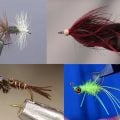Orvis Helios 2 Out Now
Always looking for new ways to better their products, Orvis announced the Helios 2 this month. “We changed it because we knew we could improve. And we have,” says the company.
Read the press release below for full details.
New Helios 2
When we set out to develop the fly rod that would eventually become the Helios 2, we had a few things in mind. We wanted it to feel lighter in hand, we wanted it to be significantly stronger, we wanted it to be extremely accurate, and we wanted it to be made entirely in the USA. Above all else, we wanted it to perform flawlessly on the water and leave anglers stunned at how well it fishes, casts, and fights.
We believe we’ve succeeded on all counts.
This was not a project we could afford to take lightly. Replacing the groundbreaking Helios with an even more technologically advanced rod was a daunting and demanding—but ultimately rewarding—process.
In order to make the rod a reality, we redistributed the rod blank weight to the butt
section of the rod, which reduced the swing weight by 20%. We added a proprietary material into the tip that not only provides better dampening, but also doubled the impact strength. We fine tuned the tapers, resulting in a smoother transfer of energy, added lifting capabilities, and extremely precise tracking. It’s as much about the methods we used as it is the materials. We are able to do things other manufacturers simply can’t because of the way we construct these rods.
Why did we change it? It’s a tough call, replacing a best-selling fly rod with a new one, and some people will grumble about this. But just because we created an industry-leading rod doesn’t mean we were content. We are always looking for ways to improve our products.
When the design on any new rod series is finished, we’re already researching new construction methods, new materials, and new ways of making a lightweight rod with superior strength. But the most important criteria is this: the new rod must cast better than anything before it—giving the novice angler easier, smoother casts, and giving the experienced angler more distance, accuracy, and line speed. By using the same raw materials we used to construct the Helios rod (defense-grade composites consisting of graphite fiber, unidirectional graphite scrim, and thermoplastic resins—all of which are patented by Orvis), we experimented with new ways of cutting the graphite flags and setting them up on the mandrels.
This allowed us to add a proprietary material in the tip that doubled the impact strength in that most vulnerable part of the rod—think split shot, tungsten beadheads, Clouser Minnows, and rods banging on the deck of a boat. We changed it because we knew we could improve. And we have.
How do they differ from the original Helios?
- The levered weight (how light the rod feels in the hand) is 20% lighter. Physically, the Helios 2 rods aren’t lighter than the Helios, but they feel much lighter in the hand.
- The overall strength of the rods when stressed to the maximum is 20% better than the original Helios. This added backbone is evident when fighting fish, battling wind, and reaching for those extra few feet on a cast.
- The tip impact strength is double what it was in the original Helios.
- Helios 2 rods feature a steeper taper on the graphite f lags. Note that this does not mean a rod with a soft tip and stiff butt. The new tapers we developed transfer the energy from one section of the rod to another more smoothly, which results in a smoother cast with less bounce in the rod. So little energy is lost due to the rod vibrating in an uncontrolled manner that every cast is more efficient and, as a direct result, often much more accurate.
- Tip and Mid-Flex rods show a greater difference. In some cases with the original Helios, the Tip-Flex and Mid-Flex rods were very close in total load. In the Helios 2, the difference between the two is much more apparent.
- New hardware, which we think is the best-looking hardware of any premium rod.
- The rods do feel different when casting. Sometimes you have to ease up on your power at first because the rods are so much more efficient that it does not take as much effort to get an equivalent cast.
- The new tapers are more efficient so you get the same distance with less effort.
- Because the new tapers are more efficient and there is less bounce throughout the rods, they track much better and are more accurate. How much more accurate depends on an individual’s casting ability.
What has not changed between the original Helios and Helios 2
- Gorgeous carbon rod tube.
- Lightweight, high-tech REC® Recoil guides.
- Rods are handmade in our rod shop in Manchester, Vermont and all hardware on the rods is made in USA (the rod tubes are made in China).
- Still one of the lightest f ly rods in the world. Blank weights are very close to those of the original Helios; the reel seat hardware is slightly heavier.
- The same patented graphite/thermoplastic technology. But in the Helios 2, the material is used in a different construction technique.
How do Helios 2 rods compare to the competition?
- No other rod uses our patented thermoplastic technology.
- Though it’s tough to measure, the Helios 2 tracks extremely well and is just as, if not more, accurate than any rod ever made.
- Reel seats use a 5-layer nickel plating over aluminum, which is harder for more scratch resistance than anodized aluminum.
- They are lighter in the hand (levered weight) than most other rods.
What will the rod do for me, and why?
- Because the rod bounces less and stays on track better, casts will be far more accurate.
- Because of a larger diameter butt and smaller diameter tip, short casts are effortless and longer casts are easier to perform. Stability and strength are improved without sacrificing feel or sensitivity.
- Because of the larger diameter butt, the rods have more reserve fish-fighting power without the risk of breakage.
- The smoother energy transfer along the rod from each section to the next means casting is simply more fun.
- Between the increase in overall strength and the increase in impact strength in the tip, there is less chance you’ll be without a rod in the middle of a trip.
Need to Get Your Fly Line Deep?
New from Jackson Kayak












